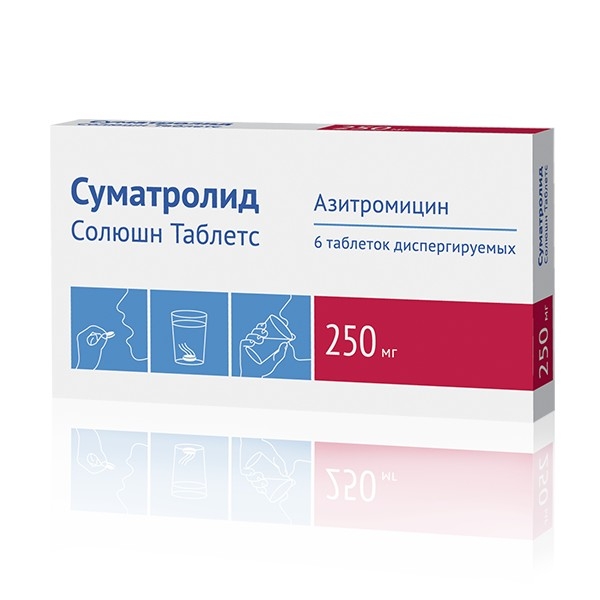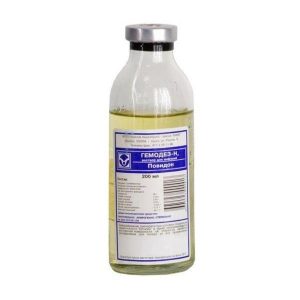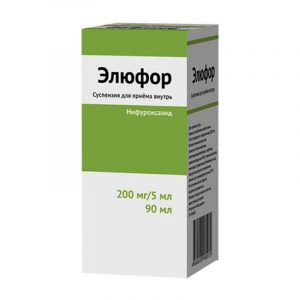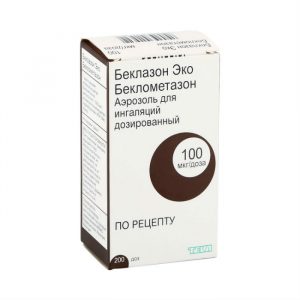Description
Pharmacological action of
Azithromycin is a macrolide antibiotic of the azalide group. By reversibly contacting the BOE subunit of the ribosome of bacterial cells, it disrupts the translocation of the growing polypeptide chain from the aminoacyl to the peptidyl region, which leads to the suppression of protein synthesis in bacterial cells.
Sensitive: aerobic gram-positive microorganisms – Staphylococcus aureus (methicillin-sensitive), Streptococcus pneumoniae (penicillin-sensitive),
Streptococcus pyogenes, Streptococcus group A, B, C, G aerobic Gram-negative bacteria, Microorganidae, Mammoferidae, , Neisseria gonorrhoeae anaerobic microorganisms – Clostridium perfringens, Fusobacterium spp., Prevotella spp., Porphyromonas spp. others – Chlamydia trachomatis, Chlamydia pneumoniae, Chlamydia psittaci, Mycoplasma pneumoniae, Mycoplasma hominis, Borrelia burgdorferi. Moderately sensitive or insensitive: aerobic gram-positive microorganisms – Streptococcus pneumoniae (moderately sensitive or resistant to penicillin). Resistant: aerobic gram-positive microorganisms -Enterococcus faecalis, Staphylococcus spp. (methicillin-resistant) anaerobes: Bacteroides fragilis group.
Streptococcus pneumoniae, beta hemolytic Streptococcus spp. groups A, Enterococcus faecalis and Staphylococcus aureus (including methicillin-resistant strains), resistant to erythromycin and other macrolides, lincosamides are resistant to azithromycin.
Pharmacokinetics
After oral administration, bioavailability is 37%, the maximum concentration in blood plasma (C max) is created after 2-3 hours, the volume of distribution is 31 l / kg. Binding to plasma proteins is inversely proportional to the concentration in the blood and is 12-52%. Penetrates through cell membranes (effective in infections caused by intracellular pathogens). It is transported by phagocytes, polymorphonuclear leukocytes and macrophages to the site of infection, where it is released in the presence of bacteria. Easily passes through histohematological barriers where it is released in the presence of bacteria. Easily passes through histohematological barriers where it is released in the presence of bacteria. Easily passes through histohematological barriersand enters the tissue. The concentration in tissues and cells is 50 times higher than in blood plasma, and in the focus of infection – 24-34% more than in healthy tissues. It is slowly excreted from the tissues and has a long half-life of 2-4 days. The therapeutic concentration of azithromycin lasts up to 5-7 days after the last dose. Azithromycin is excreted mainly unchanged – 50% of the intestine, 12% of the kidneys. In the liver, demethylates, losing activity. In patients with renal failure (creatinine clearance (CC) less than 10 ml / min), the half-life of azithromycin is increased by 33%.
Indications
Infectious and inflammatory diseases, caused by microorganisms sensitive to azithromycin:
Infections of the upper respiratory tract and ENT organs (pharyngitis, tonsillitis, sinusitis, otitis media)
Infections of the lower respiratory tract (acute bronchitis, exacerbation of chronic bronchitis, community-acquired pneumonia, including those caused by atypical)
Infections of the skin and soft tissues (common acne of moderate severity, erysipelas, impetigo, secondarily infected dermatoses)
The initial stage of Lyme disease (borreliosis) – erythema migrans (erythema migrans)
Uncomplicated projection of the urinary tract caused by Chlamidia trachomatis (urethritis, cervicitis).
Contraindications
Hypersensitivity to azithromycin, other macrolides, drug components, simultaneous use with ergot derivatives, severe liver failure (Child-Pugh class B and C). Severe renal failure (CC less than 40 ml / min). Children’s age up to 6 months.
Caution
Long QT interval syndrome, chronic renal failure (CC more than 40 ml / min), liver failure (Child-Pugh class A), myasthenia gravis, concomitant use with terfenadine, warfarin, digoxin, drugs, lengthening the QT interval.
Special instructions
If you miss one dose of the drug, you should take the missed dose as soon as possible, and the subsequent ones with 24 hour intervals. With pharyngitis and tonsillitis caused by Streptococcus pyogenes, penicillins are the antibiotics of choice. The effectiveness of azithromycin for the prevention of rheumatic fever is unknown.
Use with caution in patients with hepatic insufficiency (Child-Pugh class A) because of the potential for fulminant hepatitis and severe liver failure in these patients. In the presence of symptoms of impaired liver function (rapidly growing asthenia, jaundice, dark urine, a tendency to bleed, hepatic encephalopathy), azithromycin therapy should be discontinued and a study of the functional state of the liver should be carried out. In renal failure (CC more than 40 ml / min), the use of azithromycin should be carried out under the control of renal function.
When using azithromycin, as well as when using other antibiotics, there is a risk of developing superinfection (including fungal infection).
With prolonged use of azithromycin, pseudomembranous colitis caused by Clostridium difficile may develop. With the development of diarrhea while taking azithromycin, and also 2 months after the end of therapy, clostridial pseudomembranous colitis should be excluded. In mild cases, discontinuation of treatment and the use of ion-exchange resins (cholesterol, colestipol) is sufficient, in severe cases, compensation for loss of fluid, electrolytes and protein, the appointment of vancomycin, bacitracin or metronidazole are indicated.
Do not use drugs that inhibit intestinal motility.
Since it is possible to prolong the QT interval in patients receiving macrolides, including azithromycin, when using azithromycin, caution should be exercised in patients with known risk factors for prolonging the QT interval: old age, electrolyte imbalance (hypokalemia, hypomagnesemia), congenital prolongation of the QT interval, disease heart (heart failure, myocardial infarction, bradycardia), concomitant use of drugs capable of lengthening the QT interval (including antiarrhythmic drugs class IA and III drugs, tricyclic and tetracyclic antidepressants, antipsychotics, fluoroquinolones). With the use of azithromycin, the development of myasthenic syndrome or exacerbation of myasthenia is possible.
Effect on the ability to drive vehicles and mechanisms
In case of adverse reactions from the nervous system, patients are advised to refrain from driving and other mechanisms, as well as to exercise caution when engaging in activities that require increased concentration and speed of psychomotor reactions.
Composition
Composition per 1 tablet: active substance: azithromycin dihydrate 265.3 mg, in terms of azithromycin 250.0 mg
excipients: microcrystalline cellulose 225.9 mg, crospovidone 60.3 mg, Pregelatinized starch 67.0 mg, blackcurrant flavor 5.0 mg, magnesium stearate 6.0 mg, sodium saccharin 15.0 mg, vanillin 1.5 mg, colloidal silicon dioxide 24.0 mg.
Dosage and administration
Inside, once a day, at least 1 hour before or 2 hours after eating.
Adults (including older people) and children over 12 years old with body weight over 45 kg.
For infections of the upper and lower respiratory tract, ENT organs, skin and soft tissues: 500 mg (2 tablets) 1 time per day for 3 days (course dose of 1.5 g)
Initial stage of Lyme disease: 1 time per day for 5 days: 1st day – 1.0 g (4 tablets), then from 2nd to 5th day – 500 mg (2 tablets) (course dose 3.0 g)
For uncomplicated urinary tract infections caused by Chlamidia trachomatis (urethritis, cervicitis): 1 g (4 tablets) once.
For acne: the course dose is 6 g: 500 mg (2 tablets) 1 time per day for 3 days, then 500 mg 1 time per week for 9 weeks.
For children from 6 months to 12 years.
For infections of the respiratory tract, ENT organs, skin and soft tissues: Based on 10 mg / kg of body weight 1 time per day for 3 days (course dose of 30 mg / kg).
With streptococcal pharyngitis: Based on 10-20 mg / kg 1 time per day for 3 days.
The initial stage of Lyme disease: on the 1st day – at a dose of 20 mg / kg body weight and then from 2 to 5 days – daily at a dose of 10 mg / kg body weight (course dose of 60 mg / kg).
Prescribing to patients with impaired renal function: For patients with moderate impaired renal function (CC> 40 ml / min), dose adjustment is not necessary.
Dispersible tablets can be taken in various ways: the tablet can be swallowed whole, washed down with water or previously dissolved in water before use. Tablets should be dissolved in at least 50 ml of water. Before taking, thoroughly mix the resulting suspension.
Side effects of
From the hemopoietic organs: lymphocytopenia, eosinophilia, leukopenia, thrombocytopenia, transient neutropenia, hemolytic anemia.
From the side of the nervous system: dizziness, vertigo, drowsiness, headache, cramps, paresthesia, hyposthesia, asthenia, insomnia, hyperactivity, aggression, anxiety, anxiety, nervousness.
On the part of the sensory organs: hearing impairment, deafness, ringing in the ears, perversion of taste or smell, decreased visual acuity.
From the cardiovascular system, palpitations, decreased blood pressure, arrhythmia (including ventricular tachycardia, pirouette tachycardia), QT interval lengthening.
From the digestive system: nausea, vomiting, diarrhea, abdominal pain or cramping in the abdomen, loose stools, flatulence, indigestion, gastritis, anorexia, constipation, discoloration of the tongue, pseudomembranous colitis, hepatitis, cholestatic jaundice, impaired liver function tests, liver necrosis and liver failure (up to a fatal outcome), pancreatitis, fulminant hepatitis.
From the skin: itching and rash, angioedema, urticaria, photosensitivity, erythema multiforme, Stevens-Johnson syndrome, toxic epidermal necrolysis, anaphylactic reactions.
From the musculoskeletal system: arthralgia.
From the genitourinary system: vaginitis, interstitial nephritis, acute renal failure.
Lab performance: an increase in the concentration in the blood serum of bilirubin, urea, creatinine, potassium ions, a decrease in the concentration in the blood serum of bicarbonates.
Other: candidiasis, chest pain, peripheral edema, fainting, exacerbation of myasthenia gravis, malaise, hyperglycemia.
Overdose
Symptoms: temporary hearing loss, nausea and vomiting, diarrhea.
Treatment: taking activated carbon, maintaining vital body functions.
Storage conditions
In the dark place at a temperature of no higher than 25 ° C.
Keep out of the reach of children.
Expiration
3 years.
Do not use after expiration date.
dosage form
tablets soluble




